Huawei P10 and P10 Plus: Performance & Battery Life Report
by Matt Humrick on May 12, 2017 7:00 AM ESTBattery Life
The Huawei P10 pairs the Kirin 960 SoC with a 3200 mAh (12.23 Wh) battery, a small capacity bump from the P9’s 3000 mAh unit. The P10 Plus, which also uses the Kirin 960, gets a battery capacity increase too, up from the P9 Plus’ 3400 mAh to 3750 mAh (14.33 Wh). In our analysis of Kirin 960, we were surprised to see a regression in power efficiency relative to last year’s Kirin 950/955, despite using the newer Cortex-A73 CPU cores that are supposed to consume 20%-30% less power than the Kirin 950’s A72 cores (same process, same frequency), according to ARM; however, the Mate 9 (Kirin 960, 4000 mAh battery) managed to improve battery life relative to the Mate 8 (Kirin 950, 4000 mAh battery) by saving power elsewhere, notably with a more efficient display. Did Huawei find similar power savings with its P10 and P10 Plus?
To find out, we’ll run them through our standard suite of battery tests. To make the tests accurate and repeatable, we control as many variables as possible, including minimizing background tasks and calibrating each display to 200 nits at 100% APL.
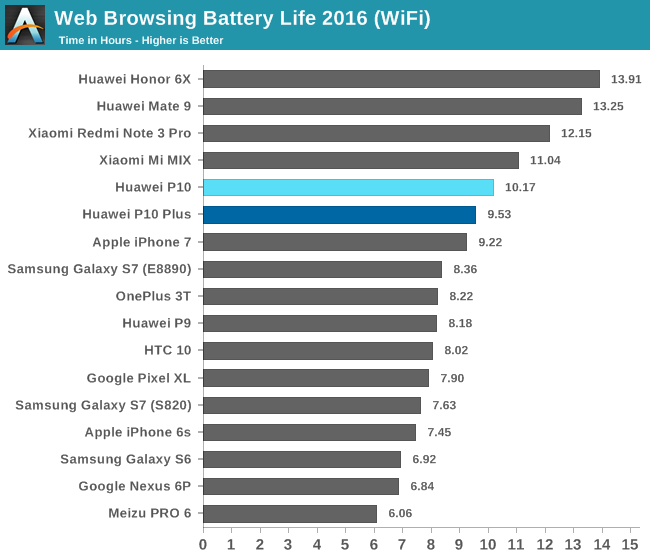
The P10 does quite well in our Wi-Fi browsing test that loads, pauses, and then scrolls through a set of popular websites while connected to Wi-Fi with the cellular radio turned off. Its 10 hours of screen on time is a 2 hour improvement on the P9. It definitely looks like Huawei has shaved power consumption from other components, because this increase is larger than what the bigger battery alone can explain. The P10 Plus uses more power on average than the P10 and its smaller, lower-resolution display, giving it just under 10 hours of screen on time in this test, which is still better than competing phones such as the Galaxy S7, OnePlus 3T, and Google Pixel XL.
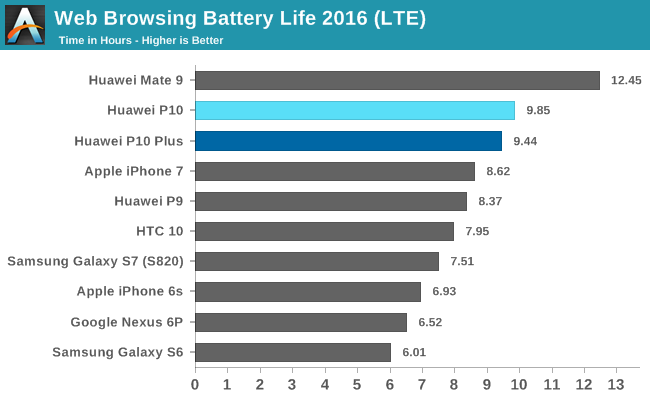
When using the cellular radio instead of Wi-Fi, the P10 once again lasts longer than the P10 Plus. The average platform power consumption (which is extrapolated from total runtime and battery capacity) is once again very similar between the P10 and Mate 9, with the P10 using 276-300mW less power on average than the P10 Plus.
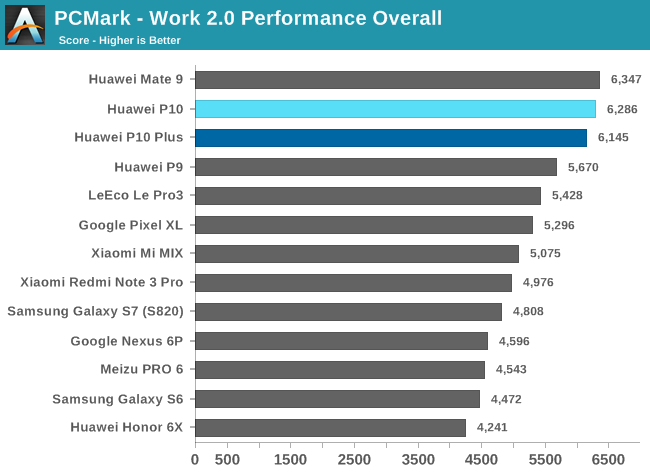
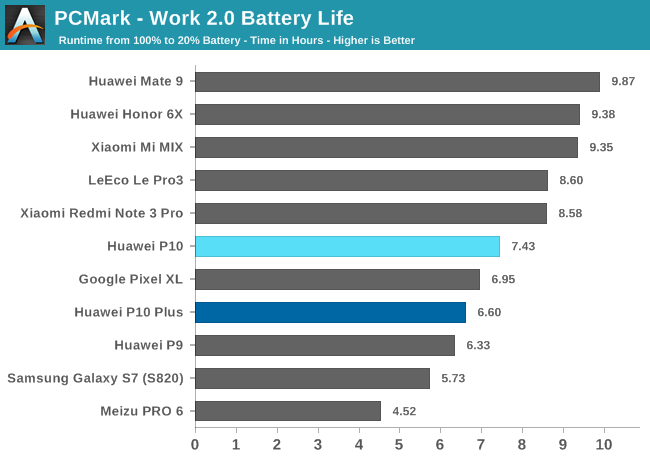
PCMark’s mixture of everyday workloads make better use of the CPU, GPU, and memory subsystems than our browsing battery life tests, which are still mostly limited by the power consumption of the display. With more work to do—and more frequent use of the big CPU cores and the GPU—the P10’s screen on time drops to just under 7.5 hours, a 1 hour improvement over the P9 and still a little longer than the Pixel XL. The P10 Plus only manages 6.6 hours, a far cry from the Mate 9’s nearly 10 hour duration. The Mate 9’s battery is only about 7% larger, but it lasts 50% longer in this test. Part of this difference is because of the particular Kirin 960 SoC in our P10 Plus sample, which draws more power than the parts in the P10 and Mate 9 (so a worse bin).


Most of the current flagship phones last around 3.5 hours when playing a game simulation like Manhattan ES 3.1, maybe a little longer if they have a larger-than-average battery. The P10 Plus only manages about 3 hours, the same as the P9, however. The smaller P10 dies about 15 minutes sooner, which is not a great result.
Of course we need to consider sustained performance too. As a general rule, the higher the performance the lower the battery life. The iPhone 7 is a good example; it delivers the best performance in this scenario but fails to match the battery life of its peers. The P10 sustains just over 18fps compared to about 9fps for the P9, so twice the sustained performance for only 15 fewer minutes of battery life. The P10 Plus manages just over 10fps sustained, similar to the P9, but it’s rendering onscreen at 1440p instead of 1080p like P9/P10. Factoring in display resolution, the P10 Plus offers similar sustained performance to other 1440p phones, such as the Galaxy S7, HTC 10, and Pixel XL, but falls about 0.5 hours short of these phones on battery life. The P10’s sustained performance is similar to the Le Pro3, OnePlus 3T, and Mi MIX, which all use lower-resolution 1080p displays, but it falls short on battery life, partially because these other three phones have larger batteries.
GPU Thermal Stability
The 1037MHz peak operating point Huawei uses for the Mali-G71MP8 GPU in the P10, P10 Plus, and Mate 9 is intended primarily for boosting benchmark scores and is not sustainable. All three phones only maintain peak performance levels for 1 minute (which just happens to be how long most graphics benchmarks last) before they begin reducing GPU frequency to avoid overheating. The P10 drops to 21fps after only 4 minutes, a 37% reduction relative to the peak value, before reaching equilibrium after about 30 minutes at around 18.3fps. This behavior is almost exactly the same as the Mate 9, except it drops to 21fps after 8 minutes and maintains 19fps afterwards, probably because its larger chassis can dissipate more heat. The P10 Plus also loses about 38% of its performance after 8 minutes.
The P10’s and Mate 9’s sustained performance is as good as or better than phones using Qualcomm’s Snapdragon 820/821 SoCs, though. The Moto Z Force Droid, with a newer GPU driver, can sustain a peak performance of almost 18fps for 12 minutes, gradually reaching a steady-state frame rate of 14.5fps, while the LeEco Pro 3, which uses a Snapdragon 821 SoC, can maintain 19fps after dropping from a peak value of 33fps. The Galaxy S7 edge also experiences a significant 33% drop in performance starting at the 8 minute mark, stabilizing at about 10fps after 31 minutes, similar to the P10 Plus’ 10.3fps when running at the same resolution.
Once the battery level drops to 10%, Huawei’s battery saving feature, which cannot be disabled, kicks in, reducing frame rate by more than 20%. There’s another step when the battery level hits 4%.
Battery Charging
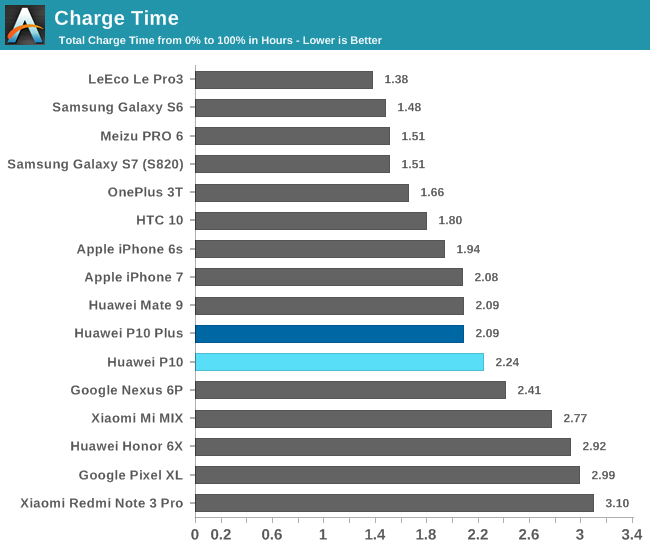
The P10 and P10 Plus include Huawei’s SuperCharge fast-charging technology that includes voltage, current, and temperature protection circuitry. The included wall charger is rated for 5V/2A (10W), 4.5V/5A (22.5W), and 5V/4.5A (22.5W) operation.
The P10 reaches a peak of about 16.2W at the battery shortly after being plugged in before settling around 12.5-13W. The battery charges to 25% in about 14 minutes and reaches 50% in about 31 minutes. The P10 Plus charges a little faster, initially spiking to 17.2W before settling around 14W. The P10 Plus’ battery charges to 25% in about 14 minutes and reaches 50% in about 30 minutes. Both P10s take just over 2 hours to be completely charged.



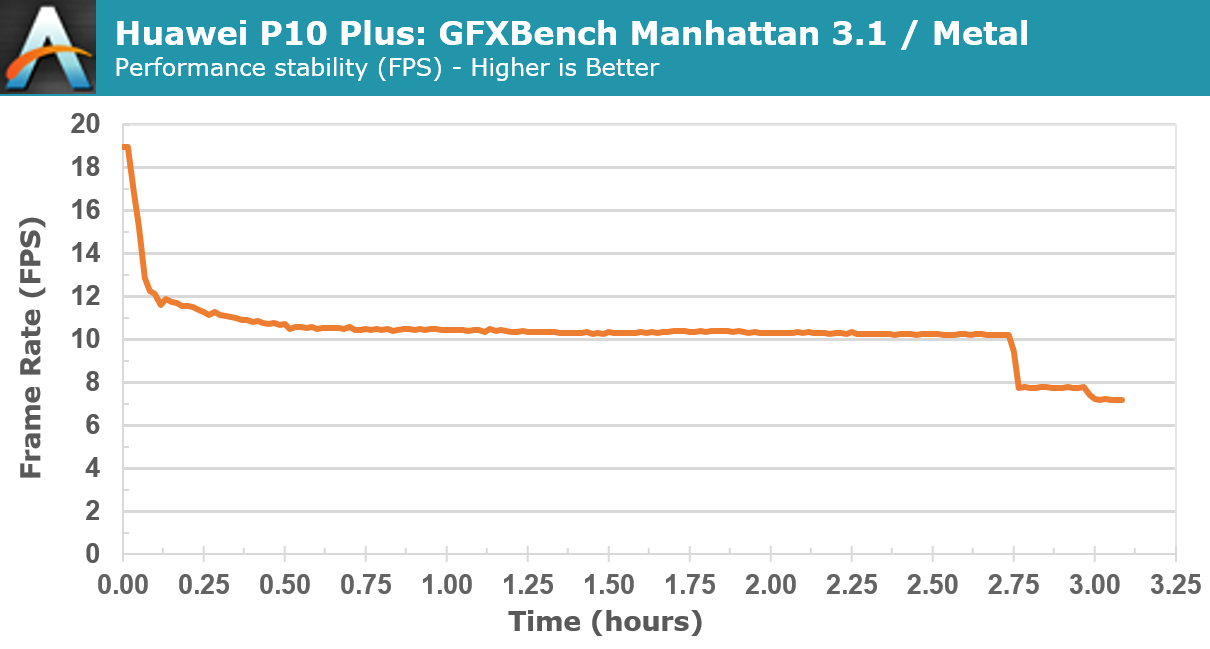
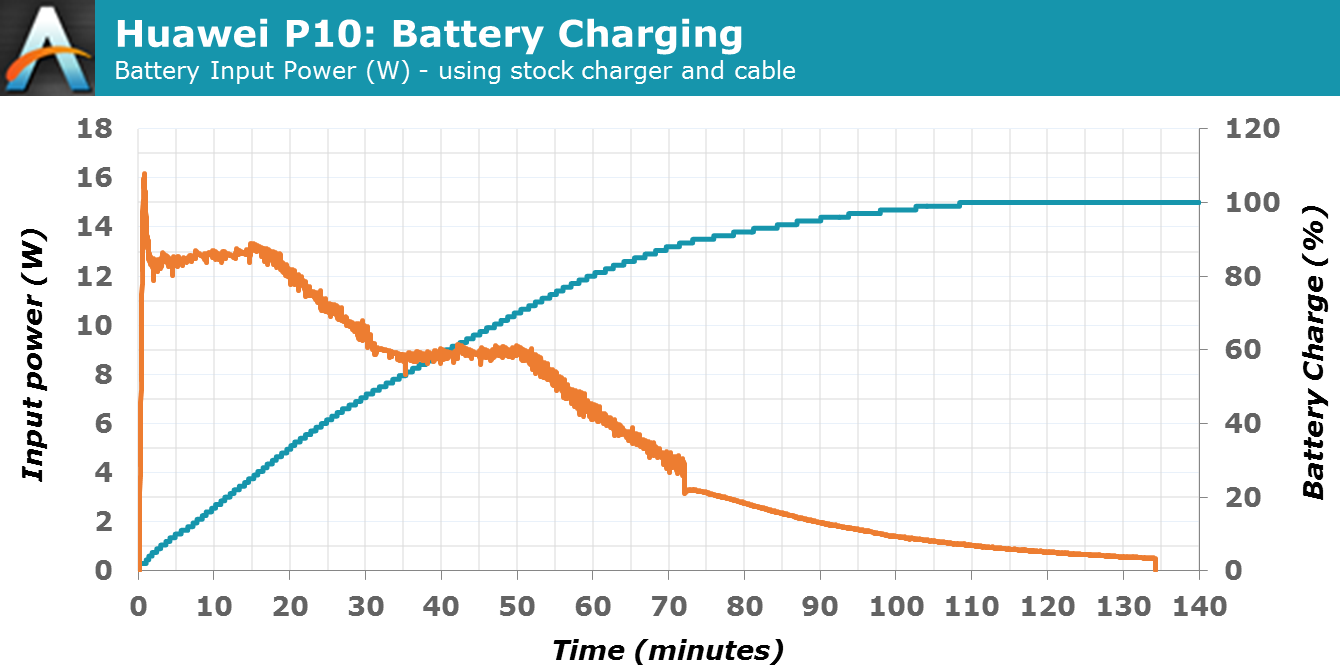
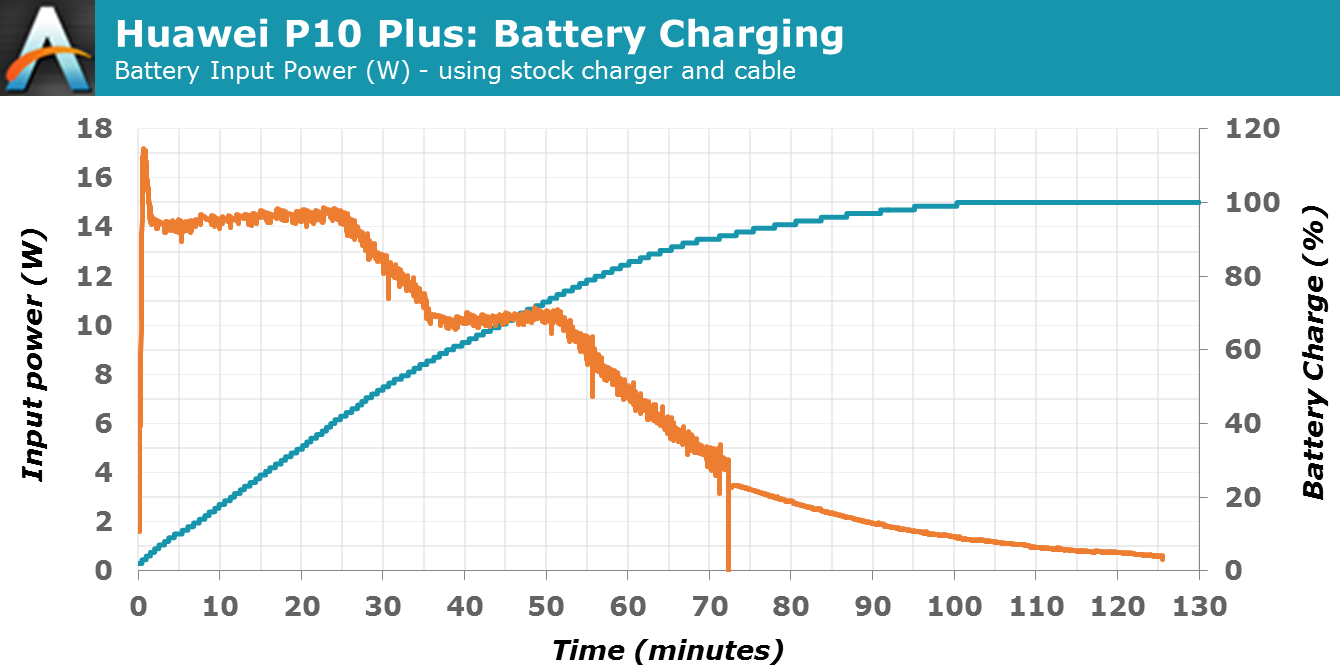








74 Comments
View All Comments
John Other - Sunday, May 14, 2017 - link
I've not used the Pixel, but can confirm that my P10 is really very smooth and responsive and a pleasure in general use.But I can absolutely imagine that with the OS familiarity Google has, on the same hardware, battery smoothness is entirely possible. Gratuitous car analogy: Mercedes-Benz not quite a Bentley.
On the other side of the coin, I think the physical build, first rate certainly, you will be able to sense as short of a iPhone 7, if you ever once use the iPhone for a while. The iPhone has the better mass distribution of the two, the P10 just a touch weighted on the left. It may be my recovering hand from injury that makes my hold less secure than before, but I went to a store specifically to jog my recollection. IPhone definitely wins in the purely illusory feeling of security in holding balance. I caveat this with the fact that during recovery from my hand in which my index finger was badly broken, I perceived that perfectly flat items like credit cards I gripped were concave. So my touch is not calibrated. However the impression I relate is that which I went to check only last week.
I should further note that my P10 replaced my LUMIA 650. This was too close a call entirely due to the LUMIA 950 XL making the only sensible decision that just does not feel sensible any longer. Other than the state of hardware, and sorely needed Edge advancements, the switch from Windows 10 Creator's Mobile, is one I simply would not have called, was a Microsoft direction visible. I think it is testimony to Steve Ballmer, how much survived, superannuated, that remains very good. Nadella appears to have had to asphyxiate the Ball er legacy plans, as if he couldn't present good reason to shut them down. Microsoft have forgotten that cutting off the air supply is supposed to be done to the competition.... But if Windows Phone is the price of maturing beyond that level of aggression, in a market where we need software integration absent hardware leaps, to drive performance, then so be it. Just to not tell the world, of such a positive game plan, beats me.
Speedfriend - Friday, May 12, 2017 - link
The thought that you can buy a product that may be totally different to the review that you have read is crazy. They should be punished by no one buying themphilehidiot - Friday, May 12, 2017 - link
Indeed - I find it very disturbing that the phones could be either a modern spec (and I have to assume Anandtech were supplied with the best possible article) or falling behind even last generation in some areas. There's a difference between SoCs which are binned and fall within a bell curve and totally different components. Yes, the difference now might be marginal in terms of experience but as software becomes more hardware intensive you expect that perceptive performance to be maintained for a reasonable timeframe - this is one reason why you're paying double for a flagship phone.I'm sorry but if someone offered me a PC and it could come with either a HDD or SSD or DDR3 or DDR4 depending on luck and oh, by the way the cost is the same regardless of what you get and we won't tell you, you'll just have to find out when you get it.... I'd tell them to fuck off. It's an absolute disgrace and sticking two fingers up at your customer. I understand there are shortages and intense competition but if you're going to do this then you DROP YOUR PRICES! You can't charge the same as a modern flagship with the risk of getting components 1-2 years out of date (relative to flagship specification).
In addition to this, you have to consider optimisation may well suffer. You've got a closed system with components all working on one system (UFS) for example and you can spend time optimising everything to work with that. Suddenly, due to suppliers, you have to optimise late in the design phase (probably when mass production techniques have already been devised and they're now looking at supply - I assume, I'm not in the industry, let me know if I'm wrong) for not just UFS but eMMC as well which adds complexity and potentially adds bugs. As WELL as slowing down updates as they end up more complex.
If you're going to violate your customers like this then you have to offer them something in return, ideally reduced cost. They are competing with standardised flagships on price and, whilst I was very interested, knowing I could be getting something markedly different to what I'm paying for makes this brand a no, no for me.
"Yes, sir, you ordered the caviar"
"Well, I appear to have a pear with a turd next to it"
"Sorry, Sir this is how our restaurant operates. We can't always get supply in to meet demand so we carry on charging the same but give you what you'd get in a dirty cafe."
"Well, I'm sorry, I'm returning this and I want a refund"
"Sorry, Sir... it did not say anywhere that you wouldn't get a pear instead and you ARE being provided with something that came out of an animal, so you have no grounds for complaint"
"Oh you can just fu......"
John Other - Sunday, May 14, 2017 - link
The P10 is by far the most modestly priced of the flagships.UK retail carrier unlocked, I think dropped below pounds 600 last week.
I find that I am soundly impressed with the understatement of this phone. Everything about it infuses me with confidence. Only a removable battery, would be my request. (for which surely there must be a elegant engineering solution (plastic backs are decades behind the build quality we expect from any other than budget categories, and the semi liquid packed character must be solvable, alongside a truly solid attachment mechanism, clip on flush not insert and cover)
I can't compare but watching the Formula One qualifying sessions yesterday, on Now TV over LTE, the sound was of a quality comfortably filling my small hotel room, all 4 by 5 yards of it, and I could make out the transmission artefacts hampered car to pit radio, and even the transmission of the cars in corners, on the internal speaker. If this is the general quality to expect nowadays, we're doing well, I don't see the need to be gloomy about the market demand for upgrades etc.
fanofanand - Friday, May 12, 2017 - link
Very generous of you to assume that the gimped phones will still be fine and dandy for the end consumer. You seem to be forgiving of the practice, or at least understanding. I am not. If you can't procure the parts you don't sell the product. This kind of bait and switch is precisely the kind of thing people will point to when they say they will "never buy a chinese phone"Matt Humrick - Friday, May 12, 2017 - link
It's not that I condone the practice, I just want people to understand that this happens frequently and why it happens. I've seen LG use display panels of significantly different quality in its G-series phones, and Samsung use different camera sensors (with equivalent specs) on its Galaxy phones that produce images that look completely different, for example. So the P10 is not even the worst example of multi-sourcing. Huawei needs to be more truthful in its advertising, though.invinciblegod - Friday, May 12, 2017 - link
Apple did something similar where the SOC was manufactured by Samsung or TSMC. Apparently, the TSMC one was slightly better but only marginally.levizx - Friday, May 12, 2017 - link
No, not even remotely close. A9 was merely manufactured by different foundries, they have identical design and spec and are pin-to-pin compatible. Difference is only the average power consumption, but even chips cut from the same wafer have different power consumption.eMMC/UFS2.x OTOH are incompatible standards, they don't resemble each other in any way.
levizx - Friday, May 12, 2017 - link
Problem is QUALITY aside, different suppliers still have nominally similar specs, ie all IPS LCD, same sensor size & pixel count.Now, I can understand mixing UFS 2.0/2.1 since they have similar specs and can nominally perform similarly.
eMMC 5.1 is a totally different standard/interface. I'll be replacing AMOLED with TN LCD.
drajitshnew - Saturday, May 13, 2017 - link
Matt I was very interested when I started the review, but lost most of my interest when the variability was revealed. Then on I just skimmed through the review.What is the point of the review if the system YOU purchase could have memory a generation behind, storage 2 generations behind, and a different bin of processor? There was a quite a ruckus when apple dual sourced CPUs with marginally different preformed.
At the very least either you or your should add caveat emptor or YMMV, in BIG BOLD letters to the end of the review. The reputation of anandtech.com deserves at least that.